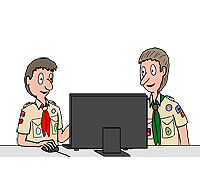
STAMP COLLECTING
These were the REQUIREMENTS
before the REVISIONS made on January 1, 2001.
To see the current requirements
Click Here
- Do the following:
- Discuss how you can better understand people, places,
institutions, history, and geography as a result of collecting
stamps.
- Briefly describe some aspects of the history, growth,
and development of the United States postal system. How
is it different from postal systems in other countries?
- Define topical stamp collecting. What are some other types
of stamp collections?
- Show at least ONE example of each of the following:
- Perforated and imperforate stamps
- Mint and used stamps
- Sheet-booklet and coil stamps
- Numbers on plate block, booklet, coil, or marginal markings
- Overprint and surcharge
- Metered mail
- Definitive, commemorative, semipostal, and airmail stamps
- Cancellation and postmark
- First day cover
- Postal stationery (aerogramme, stamped envelope, and
postal card)
- Do the following:
- Demonstrate the use of ONE standard catalog for several
different stamp issues. Explain why catalog value can vary
from the corresponding purchase price.
- Explain the meaning of the term CONDITION as used to
describe a stamp. Show examples that illustrate the different
factors that affect a stamp's value.
- Demonstrate the use of at least THREE of the following stamp
collector's tool:
- Stamp tongs
- Water and Tray
- Magnifier(s)
- Hinges
- Perforation gauge
- Envelopes and sleeves
- Watermark fluid
- Do the following:
- Show a stamp album and how to mount stamps with or without
hinges. Show at least ONE page that displays several stamps.
- Discuss at least THREE ways you can help to preserve
stamps, covers, and albums in first-class condition.
- Do at least TWO of the following:
- Design a stamp, cancellation, or cachet.
- Visit a post office, stamp club, or stamp show with
an experienced collector. Explain what you saw and/or did.
- Write a review of an interesting article from a stamp
newspaper, magazine, or book.
- Research and report on a famous stamp-related personality
or the history behind a particular stamp.
- Describe the steps taken to produce a stamp. include
the methods of printing, types of paper, perforation styles,
and how they are gummed.
- Prepare a two-to-three page display involving stamps.
Using ingenuity, as well as clippings, drawings, etc., tell
a story about the stamps. How do they relate to history,
geography, or a favorite topic of yours?
- Mount and show, in a purchased or homemade album, ONE of
the following:
- A collection of 250 or more different stamps from at
least 15 countries.
- A collection of a stamp from each of 50 different countries,
mounted on maps to show the location of each.
- A collection of 100 or more different stamps from either
one country or a group of closely related countries.
- A collection of 75 or more different stamps on a single
topic. (Some interesting topics are Scouts, birds, insects,
the Olympics, sports, flowers, animals, ships, Christmas,
trains, famous people, space, medicine, etc.) Stamps may
be from different countries.
- A collection of postal items discovered in your mail
by monitoring over a period of thirty days. Include at least
five different types listed in requirement 3, above.
BSA Advancement ID#: 108
Pamphlet Revision Date: 1997
Requirements last revised in 1993
|





